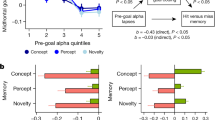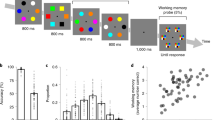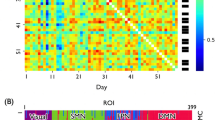Abstract
Attention is a fundamental cognitive process that is critical for essentially all aspects of higher-order cognition and real-world activities. Younger generations have deeply embraced information technology and multitasking in their personal lives, school and the workplace, creating myriad challenges to their attention. While improving sustained attention in healthy young adults would be beneficial, enhancing this ability has proven notoriously difficult in this age group. Here we show that 6 weeks of engagement with a meditation-inspired, closed-loop software program (MediTrain) delivered on mobile devices led to gains in both sustained attention and working memory in healthy young adults. These improvements were associated with positive changes in key neural signatures of attentional control (frontal theta inter-trial coherence and parietal P3b latency), as measured by electroencephalography. Our findings suggest the utility of delivering aspects of the ancient practice of focused-attention meditation in a modern, technology-based approach and its benefits on enhancing sustained attention.
This is a preview of subscription content, access via your institution
Access options
Access Nature and 54 other Nature Portfolio journals
Get Nature+, our best-value online-access subscription
$29.99 / 30 days
cancel any time
Subscribe to this journal
Receive 12 digital issues and online access to articles
$119.00 per year
only $9.92 per issue
Buy this article
- Purchase on Springer Link
- Instant access to full article PDF
Prices may be subject to local taxes which are calculated during checkout






Similar content being viewed by others
Data availability
The data that support the findings of this study are available from the corresponding authors on reasonable request.
Code availability
The code used in the analysis of EEG data reported in this paper is available from the corresponding authors on reasonable request.
References
Rideout, V. J., Foehr, U. G. & Roberts, D. F. Generation M2: Media in the Lives of 8- to 18-Year-Olds (Henry J. Kaiser Family Foundation, 2010).
Moisala, M. et al. Media multitasking is associated with distractibility and increased prefrontal activity in adolescents and young adults. Neuroimage 134, 113–121 (2016).
Ophir, E., Nass, C. & Wagner, A. D. Cognitive control in media multitaskers. Proc. Natl Acad. Sci. USA 106, 15583–15587 (2009).
Ralph, B. C., Thomson, D. R., Cheyne, J. A. & Smilek, D. Media multitasking and failures of attention in everyday life. Psychol. Res. 78, 661–669 (2014).
Chun, M. M., Golomb, J. D. & Turk-Browne, N. B. A taxonomy of external and internal attention. Annu. Rev. Psychol. 62, 73–101 (2011).
Posner, M. I. & Petersen, S. E. The attention system of the human brain. Annu. Rev. Neurosci. 13, 25–42 (1990).
Anguera, J. A. et al. Video game training enhances cognitive control in older adults. Nature 501, 97–101 (2013).
Cortese, S. et al. Cognitive training for attention-deficit/hyperactivity disorder: meta-analysis of clinical and neuropsychological outcomes from randomized controlled trials. J. Am. Acad. Child Adolesc. Psychiatry 54, 164–174 (2015).
Tang, Y. Y. & Posner, M. I. Attention training and attention state training. Trends Cogn. Sci. 13, 222–227 (2009).
Bediou, B. et al. Meta-analysis of action video game impact on perceptual, attentional, and cognitive skills. Psychol. Bull. 144, 77–110 (2018).
Brefczynski-Lewis, J. A., Lutz, A., Schaefer, H. S., Levinson, D. B. & Davidson, R. J. Neural correlates of attentional expertise in long-term meditation practitioners. Proc. Natl Acad. Sci. USA 104, 11483–11488 (2007).
Simons, D. J. et al. Do “brain-training” programs work? Psychol. Sci. Public Interest 17, 103–186 (2016).
Weyandt, L. L. et al. Prescription stimulant medication misuse: where are we and where do we go from here? Exp. Clin. Psychopharmacol. 24, 400–414 (2016).
Benson, K., Flory, K., Humphreys, K. L. & Lee, S. S. Misuse of stimulant medication among college students: a comprehensive review and meta-analysis. Clin. Child Fam. Psych. 18, 50–76 (2015).
Herman, L. et al. The use of prescription stimulants to enhance academic performance among college students in health care programs. J. Physician Assist. Educ. 22, 15–22 (2011).
Lutz, A., Slagter, H. A., Dunne, J. D. & Davidson, R. J. Attention regulation and monitoring in meditation. Trends Cogn. Sci. 12, 163–169 (2008).
Chiesa, A., Calati, R. & Serretti, A. Does mindfulness training improve cognitive abilities? A systematic review of neuropsychological findings. Clin. Psychol. Rev. 31, 449–464 (2011).
Zeidan, F., Johnson, S. K., Gordon, N. S. & Goolkasian, P. Effects of brief and sham mindfulness meditation on mood and cardiovascular variables. J. Alter. Complement. Med 16, 867–873 (2010).
Morrison, A. B., Goolsarran, M., Rogers, S. L. & Jha, A. P. Taming a wandering attention: short-form mindfulness training in student cohorts. Front. Hum. Neurosci. 7, 897 (2014).
Tang, Y. Y. et al. Short-term meditation training improves attention and self-regulation. Proc. Natl Acad. Sci. USA 104, 17152–17156 (2007).
Deci, E. L., Koestner, R. & Ryan, R. M. A meta-analytic review of experiments examining the effects of extrinsic rewards on intrinsic motivation. Psychol. Bull. 125, 627–668 (1999).
Spijkerman, M. P., Pots, W. T. & Bohlmeijer, E. T. Effectiveness of online mindfulness-based interventions in improving mental health: a review and meta-analysis of randomised controlled trials. Clin. Psychol. Rev. 45, 102–114 (2016).
Mani, M., Kavanagh, D. J., Hides, L. & Stoyanov, S. R. Review and evaluation of mindfulness-based iPhone apps. JMIR Mhealth Uhealth 3, e82 (2015).
Noone, C. & Hogan, M. J. A randomised active-controlled trial to examine the effects of an online mindfulness intervention on executive control, critical thinking and key thinking dispositions in a university student sample. BMC Psychol. 6, 13 (2018).
Boot, W. R., Simons, D. J., Stothart, C. & Stutts, C. The pervasive problem with placebos in psychology: why active control groups are not sufficient to rule out placebo effects. Perspect. Psychol. Sci. 8, 445–454 (2013).
MacDonald, S. W., Nyberg, L. & Backman, L. Intra-individual variability in behavior: links to brain structure, neurotransmission and neuronal activity. Trends Neurosci. 29, 474–480 (2006).
Karalunas, S. L., Geurts, H. M., Konrad, K., Bender, S. & Nigg, J. T. Annual research review: reaction time variability in ADHD and autism spectrum disorders: measurement and mechanisms of a proposed trans-diagnostic phenotype. J. Child Psychol. Psychiatry 55, 685–710 (2014).
Gorus, E., De Raedt, R., Lambert, M., Lemper, J. C. & Mets, T. Reaction times and performance variability in normal aging, mild cognitive impairment, and Alzheimer’s disease. J. Geriatr. Psychiatry Neurol. 21, 204–218 (2008).
Tales, A. et al. Intra-individual reaction time variability in amnestic mild cognitive impairment: a precursor to dementia? J. Alzheimers Dis. 32, 457–466 (2012).
Kalin, A. M. et al. Intraindividual variability across cognitive tasks as a potential marker for prodromal Alzheimer’s disease. Front. Aging Neurosci. 6, 147 (2014).
Lutz, A. et al. Mental training enhances attentional stability: neural and behavioral evidence. J. Neurosci. 29, 13418–13427 (2009).
Braverman, E. R. et al. Delayed P300 latency correlates with abnormal test of variables of attention (TOVA) in adults and predicts early cognitive decline in a clinical setting. Adv. Ther. 23, 582–600 (2006).
Scheeringa, R. et al. Frontal theta EEG activity correlates negatively with the default mode network in resting state. Int. J. Psychophysiol. 67, 242–251 (2008).
Bledowski, C. et al. Localizing P300 generators in visual target and distractor processing: a combined event-related potential and functional magnetic resonance imaging study. J. Neurosci. 24, 9353–9360 (2004).
Clayton, M. S., Yeung, N. & Cohen Kadosh, R. The roles of cortical oscillations in sustained attention. Trends Cogn. Sci. 19, 188–195 (2015).
Mishra, J., de Villers-Sidani, E., Merzenich, M. & Gazzaley, A. Adaptive training diminishes distractibility in aging across species. Neuron 84, 1091–1103 (2014).
Sali, A. W., Courtney, S. M. & Yantis, S. Spontaneous fluctuations in the flexible control of covert attention. J. Neurosci. 36, 445–454 (2016).
Brewer, J. A. et al. Meditation experience is associated with differences in default mode network activity and connectivity. Proc. Natl Acad. Sci. USA 108, 20254–20259 (2011).
Slagter, H. A. et al. Mental training affects distribution of limited brain resources. PLoS Biol. 5, e138 (2007).
Kiyonaga, A. & Egner, T. Working memory as internal attention: toward an integrative account of internal and external selection processes. Psychon. Bull. Rev. 20, 228–242 (2013).
Paolacci, G. & Chandler, J. Inside the Turk: understanding Mechanical Turk as a participant pool. Curr. Dir. Psychol. Sci. 23, 184–188 (2014).
Reijnders, J., van Heugten, C. & van Boxtel, M. Cognitive interventions in healthy older adults and people with mild cognitive impairment: a systematic review. Ageing Res. Rev. 12, 263–275 (2013).
Boot, W. R. et al. Video games as a means to reduce age-related cognitive decline: attitudes, compliance, and effectiveness. Front. Psychol. 4, 31 (2013).
Eisendrath, S. J. et al. A randomized controlled trial of mindfulness-based cognitive therapy for treatment-resistant depression. Psychother. Psychosom. 85, 99–110 (2016).
Stevens, J. C. Applied Multivariate Statistics for the Social Sciences (Erlbaum Associates, 1986).
Cohen, J. Statistical Power Analysis for the Behavioral Sciences 2nd edn (Erlbaum Associates, 1988).
Hedeker, D., Gibbons, R. D. & Waternaux, C. Sample size estimation for longitudinal designs with attrition: comparing time-related contrasts between two groups. J. Educ. Behav. Stat. 24, 70–93 (1999).
Greenberg, L. M. TOVA Continuous Performance Test Manual (The TOVA Company, 1996).
Vogel, E. K., McCollough, A. W. & Machizawa, M. G. Neural measures reveal individual differences in controlling access to working memory. Nature 438, 500–503 (2005).
Jost, K., Bryck, R. L., Vogel, E. K. & Mayr, U. Are old adults just like low working memory young adults? Filtering efficiency and age differences in visual working memory. Cereb. Cortex 21, 1147–1154 (2011).
Lee, E. Y. et al. Visual working memory deficits in patients with Parkinson’s disease are due to both reduced storage capacity and impaired ability to filter out irrelevant information. Brain 133, 2677–2689 (2010).
Johnson, M. K. et al. The relationship between working memory capacity and broad measures of cognitive ability in healthy adults and people with schizophrenia. Neuropsychology 27, 220–229 (2013).
Clapp, W. C., Rubens, M. T., Sabharwal, J. & Gazzaley, A. Deficit in switching between functional brain networks underlies the impact of multitasking on working memory in older adults. Proc. Natl Acad. Sci. USA 108, 7212–7217 (2011).
Clapp, W. C. & Gazzaley, A. Distinct mechanisms for the impact of distraction and interruption on working memory in aging. Neurobiol. Aging 33, 134–148 (2012).
Cohen, M. X. & Cavanagh, J. F. Single-trial regression elucidates the role of prefrontal theta oscillations in response conflict. Front. Psychol. 2, 30 (2011).
Wickens, C., Kramer, A., Vanasse, L. & Donchin, E. Performance of concurrent tasks: a psychophysiological analysis of the reciprocity of information-processing resources. Science 221, 1080–1082 (1983).
Polich, J. & Kok, A. Cognitive and biological determinants of P300: an integrative review. Biol. Psychol. 41, 103–146 (1995).
Dale, A. M., Fischl, B. & Sereno, M. I. Cortical surface-based analysis. I. Segmentation and surface reconstruction. Neuroimage 9, 179–194 (1999).
Fischl, B., Sereno, M. I. & Dale, A. M. Cortical surface-based analysis. II: inflation, flattening, and a surface-based coordinate system. Neuroimage 9, 195–207 (1999).
Fischl, B., Sereno, M. I., Tootell, R. B. & Dale, A. M. High-resolution intersubject averaging and a coordinate system for the cortical surface. Hum. Brain Mapp. 8, 272–284 (1999).
Gramfort, A., Papadopoulo, T., Olivi, E. & Clerc, M. OpenMEEG: opensource software for quasistatic bioelectromagnetics. Biomed. Eng. Online 9, 45 (2010).
Tadel, F., Baillet, S., Mosher, J. C., Pantazis, D. & Leahy, R. M. Brainstorm: a user-friendly application for MEG/EEG analysis. Comput. Intell. Neurosci. 2011, 879716 (2011).
Knapp, T. R. & Schafer, W. D. From gain score t to ANCOVA F (and vice versa). Pract. Assess. Res. Eval. 14, 1–7 (2009).
Locascio, J. J. & Cordray, D. S. A reanalysis of Lord paradox. Educ. Psychol. Meas. 43, 115–126 (1983).
Polich, J. Updating P300: an integrative theory of P3a and P3b. Clin. Neurophysiol. 118, 2128–2148 (2007).
Papenberg, G., Hammerer, D., Muller, V., Lindenberger, U. & Li, S. C. Lower theta inter-trial phase coherence during performance monitoring is related to higher reaction time variability: a lifespan study. Neuroimage 83, 912–920 (2013).
Delorme, A. & Makeig, S. EEGLAB: an open source toolbox for analysis of single-trial EEG dynamics including independent component analysis. J. Neurosci. Methods 134, 9–21 (2004).
Tallon-Baudry, C., Bertrand, O., Delpuech, C. & Pernier, J. Stimulus specificity of phase-locked and non-phase-locked 40 Hz visual responses in human. J. Neurosci. 16, 4240–4249 (1996).
Johnson, R. Jr. On the neural generators of the P300 component of the event-related potential. Psychophysiology 30, 90–97 (1993).
Acknowledgements
We thank H. Cho, S. Corona, A. Ho, K. Huang, J. Kang, D. Kingsbrook, R. LoPilato, M. Kim, J. Martin, L. Martin, A. Recinos and M. Torres for help with data collection and T. Zanto for advice on EEG data analysis and interpretation. Thanks to A. Denison-Afifi, A. Speight, K. Stern, K. Weber and numerous other volunteers at Zynga.org for assistance in designing and building the MediTrain software and to A. Duanmu for critical programming support of the application during the study. We also thank R. Campusano, J. Gazzaley, A. Leggitt and H. Weng for helpful discussions. Thanks to all of our participants and to Apple who generously provided many of the iPads used in this study. Jamie Gates, Evan and Sara Williams, Zynga.org and NIH grants R21 AG041071 and R01 AG049424 provided financial support for this research. The funders had no role in study design, data collection and analysis, decision to publish or preparation of the manuscript.
Author information
Authors and Affiliations
Contributions
D.A.Z., A.J.S., S.S., J.M., J.A.A. and A.G. designed the experiments. D.A.Z., J.R.J., J.K. and A.G. developed the MediTrain software. D.A.Z., A.J.S., S.S., J.J.V. and C.E.R. collected the data. D.A.Z., A.J.S., C.L.G., S.S., J.J.V. and J.A.A. analysed the data. D.A.Z., A.J.S. and A.G. wrote the paper. All authors discussed the results and contributed to editing the manuscript.
Corresponding authors
Ethics declarations
Competing interests
A.G. is co-founder, shareholder, BOD member and advisor for Akili Interactive, a company that produces therapeutic video games. MediTrain and the apps used for the control condition are not currently associated with Akili. The other authors declare no competing interests.
Additional information
Publisher’s note: Springer Nature remains neutral with regard to jurisdictional claims in published maps and institutional affiliations.
Supplementary information
Supplementary Information
Supplementary Methods, Supplementary Figures 1–7 and Supplementary Table 1.
Rights and permissions
About this article
Cite this article
Ziegler, D.A., Simon, A.J., Gallen, C.L. et al. Closed-loop digital meditation improves sustained attention in young adults. Nat Hum Behav 3, 746–757 (2019). https://doi.org/10.1038/s41562-019-0611-9
Received:
Accepted:
Published:
Issue Date:
DOI: https://doi.org/10.1038/s41562-019-0611-9
This article is cited by
-
The impact of mindfulness apps on psychological processes of change: a systematic review
npj Mental Health Research (2024)
-
Imagination-based loving-kindness meditation and focused attention meditation temporarily enhance responses to pain in different ways: an ERP study
Current Psychology (2024)
-
Enhancing attention in children using an integrated cognitive-physical videogame: A pilot study
npj Digital Medicine (2023)
-
Transfer effects of abacus training on cognition
Current Psychology (2023)
-
Leveraging technology to personalize cognitive enhancement methods in aging
Nature Aging (2022)



